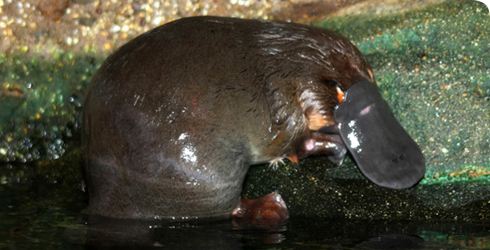Ornithorhynchus anatinus (platypus)
No other animal on Earth looks quite like the platypus, with its mixture of reptilian and mammalian features.
The most distinctive feature is the bill, which is not hard like the bill of a duck but soft and pliable. It is well supplied with nerves and is used by the animal to locate food and to find its way around under water.
Although known to have had several fossil relatives, Ornithorhynchus anatinus is the only living species of platypus.
Species detail
-

Taxonomy
Learn about the platypus' blend of reptilian and mammalian features and the characteristics that makes it well-suited for swimming and digging.
-

Distribution and ecology
The platypus is only found in Australia, where it lives in freshwater habitats. Although widely distributed, in some areas the population is very sparse and appears to have disappeared from others. Find out more about the distribution, habitat and feeding habits of this unusual-looking animal.
-

Biology
Platypuses can live up to 21 years in the wild and have some very interesting and unusual characteristics for mammals. Perhaps most noteworthy is that they lay eggs rather than giving birth to live young. Another rare feature is the production of venom by males. Find out more about the biology of Ornithorhynchus anatinus.
-

Behaviour and associations
Platypuses are generally solitary animals that spend a lot of time tucked away in burrows. Learn more about their behaviour and the parasites that affect them.
-

Conservation
Although the platypus has become extinct from some areas of Australia, it is classified as Least Concern on the IUCN Red List of Threatened Species. Find out why and what threatens this species, as well as what legislation exists to protect it.
-

References
Get reference material for Ornithorhynchus anatinus.
About the author
Common names
- Platypus, or duck-billed platypus (English)
- Ornitorrinco (Spanish)
- Ornithorynque (French)
- Ornitorrinco (Portuguese)

